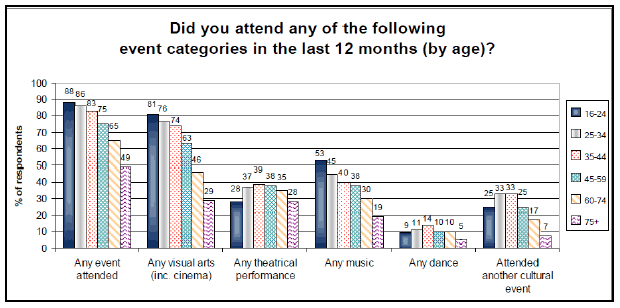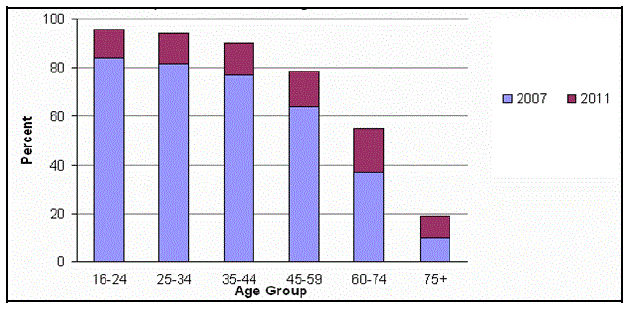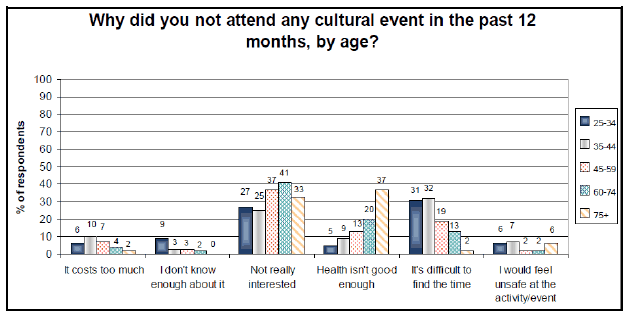Scottish Government Equality Outcomes: Age Evidence Review
This evidence review was prepared to support the production of the Scottish Government's Equality Outcomes, with regard to age.
14 Culture
14.1 This section explores available evidence on cultural participation.
14.2 Scottish Household Survey Annual Report, 2011[164], found that: in 2011, the percentage of adults who have engaged in culture in the previous year (those who attended a cultural event or participated in any cultural activity) decreased with increasing age (from 93% of those aged 16 to 24 to 85% of those aged 60 to 74). The figure for cultural engagement is lower for those aged 75 and above (74%).
14.3 Cultural attendance at specific events or places vary by age for particular events or places. However, overall attendance at any cultural event is highest for the younger age groups and lowest for the oldest age groups.
14.4 Differences between the youngest and oldest age groups are most marked for cinema attendance and for attendance at live music events. Four fifths of 16 to 24 year olds state that they have viewed films at the cinema in the last 12 months, compared with 13% of those aged 75 or greater. Over four out of ten (41%) of 16 to 24 year olds state that they have attended a live music event in the last 12 months. This compares with 20% of 60 to 74 year olds and 9% of those aged 75 or greater.
14.5 Levels of cultural participation in any activity in the previous year are broadly constant for those aged 16 to 74 (at around 74%) whilst participation levels are lower for those aged 75 or over (67%).
14.6 Participation in some but not all cultural activities decreases with increasing age of respondent. For instance, participation in dance is most popular amongst 16 to 24 year-olds (26%), whilst the figure drops to 14% for 60 to 74 year olds and 7% for those aged 75 or above[165].
14.7 The 2007/8 Scottish Household Survey[166] elaborates on the age profile for attendance at cultural events (see Figure 17). It shows that there is a strong negative relationship between age and attendance at cultural events. It can be seen that 88% of respondents between 16-24 years attended some kind of cultural event in the previous 12 months, as opposed to 65% of those aged 60-74 years and 49% of those aged over 75 years. This difference is most likely to be primarily attributed to the youngest age group attending visual arts such as cinema, much more than their older counterparts (81% v 29%). When looking at other categories of cultural events it is noticeable that the overall trend is not constant throughout, since the age group 35-44 years were the most likely to attend a theatrical performance, a dance event and other cultural events.
Figure 17: Attendance at cultural events in the past 12 months, by age (Source: Scottish Household Survey, 2007/8)

14.1 The Scottish Household Survey 2007/8 further observes that the category relating to creating music using a computer highlights the growing prevalence of computers in society and suggests that the younger age groups have embraced the technology to a greater extent than older groups. The National Indicator data from Scotland Performs[167] show that use of the Internet for personal use is strongly linked to age (see Figure 18). In 2011 over nine out of ten 16-34 year olds used the internet for personal use, compared to less than six out of ten 60-74 year olds and around two out of ten people aged 75 and older. Over the four years to 2011 all age groups have seen increases in the proportion of people using the internet for personal use. Those aged 45-74 have seen the greatest increase and the 75 and older age group has seen the smallest increase.
Figure 18: Proportion of adults using the Internet for personal use (Source: Scotland Performs: National Indicators, 2011)

14.2 The Scottish Household Survey 2007/8[168] also concludes that the main factors that influence frequency of attendance vary widely between age groups. Having more free time was the top response for those aged 25-59 years, but it is interesting to note the different top responses for the older age groups. The most common response for those aged 60-74 years was that cheaper admission prices would encourage them to attend more frequently. One fifth of those aged 60-74 years stated that more performances and events about subjects that interest them was the most important factor, which was higher than any other age group. This suggests that perhaps the content of events does not appeal to these particular age groups and that cheaper admission prices would therefore not be a motivating factor.
14.3 Figure 19 shows the reasons for non-attendance for those who did not attend cultural events by age (excluding the 16-24 years age group where too few people answered this question). Those aged between 25 and 44 years were more likely to be unable to find the time for culture. This would reflect the ages at which people are busy bringing up children or with their careers. In contrast, those aged 60 years or above were more likely to state that their health was not good enough or that they were not interested.
Figure 19: Main reason for not attending cultural events, by age (Source: Scottish Household Survey 2007/8)

14.4 A MORI study of young people's cultural activities in 2003[169] included a survey of 62 schools in Scotland; questionnaires completed by 1543 pupils aged 11-16 years; 2,124 interviews with this pupils aged 11-16 years; and a representative quota sample of 972 young people aged 17-25 years were surveyed and interviewed across 85 enumeration districts in Scotland. The study found that:
- over half (55%) of 17-25 year olds agreed with the statement that 'Scotland is a creative culture, with lots of fresh ideas', and that their topics of conversation ranged from personal issues, to social and cultural issues e.g. television programmes, future employment, sport, cost of living, clothing and fashion, and their family's health.
- the most popular activities that this age group typically take part in on a weekly basis include watching TV (81%), listening to music (77%), going to a pub/bar (65%), going to a nightclub (54%) and listening to the radio (51%).
- in comparison, 11-16 year olds most liked to listen to music (81%), go to friends' houses (79%), watch TV or videos (77%), text friends (67%) and talk on the phone (66%). Just over half liked to 'hang about the street' and pupils living in deprived areas were more likely than other groups to report this, suggesting a financial barrier to cultural participation.
- when 17-25 year olds were asked what they would like to do more of in their free time, 26% mentioned going to the gym, 15% to live music events, 11% to do volunteering, and 9% to go to a leisure centre.
- amongst 11-16 years olds the responses included going to the cinema (31%), volunteering (28%), go clubbing (25%), take part in sports (23%) and take music/dance/swimming lessons (17%).
14.5 A small-scale study in Scotland in 1999[170] that explored children's perceptions of and participation in the arts, examined barriers children may encounter when they wish to take part - this appears to be a useful addition, despite its publication earlier than the 10-year cut-off usually applied in this Evidence Review. Five focus group discussions took place with children aged 5-12 years in urban and rural primary school in Scotland. Amongst the findings were that although most of the children said they participated in the arts and attended events to a significant extent, with regard to events such as dance, plays or music, children's opportunities were restricted, with disinterest by parents and costs cited as barriers.
14.6 Another obstacle cited by children was the fact that exhibitions and plays tend to be adult-centred, with limited if any, attention paid to children's interests and needs. All the types of arts children said they liked in particular were forms in which they had "a significant level of control", particularly in relation to books (which they could choose when and where to read), and drawing and painting, particularly outside school.
14.7 The author argues that if children's participation in the arts is to be sustained, a child-centred approach is required. For example, few galleries and museums display children's arts, where they could see how and what other children express through the arts. The author points out that much could be gained if children were consulted about the structure of museums and galleries. The study concludes that finding the 'right way' to involve children in the arts "could make all the difference between whether some children lose all interest in the arts, or remain interested no matter what other activities they pursue at the same time".
Contact
Email: Social Research
There is a problem
Thanks for your feedback